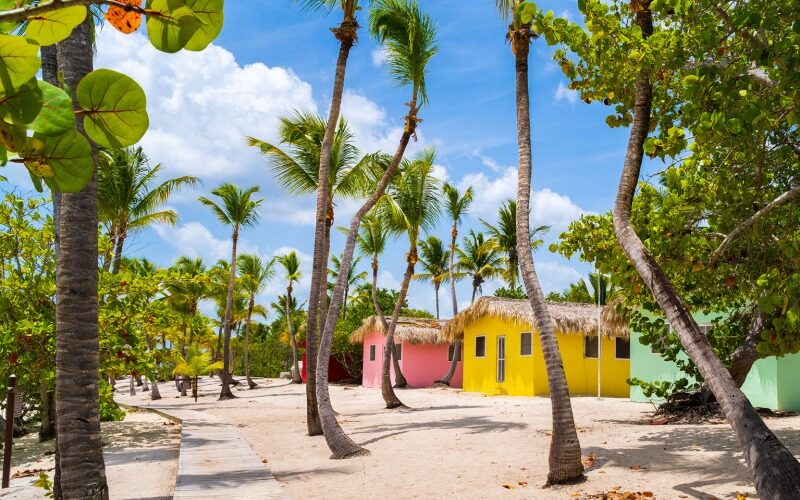What Do I Need To Know When Planning A Trip To The Dominican Republic?

The Dominican Republic is home to some of the most beautiful beaches in the world, with crystal-clear waters and white sand. Many visitors come to the country specifically to relax and soak up the sun on the beach. They have a wide variety of all-inclusive resorts that offer everything from food and drinks to activities and entertainment. Many visitors enjoy the convenience of having everything included in one package.
But that’s not all; the country offers a variety of outdoor activities, including hiking, zip lining, surfing, and scuba diving. The varied terrain includes mountains, rainforests, and beaches, offering plenty of opportunities for adventure.
Also, the Dominican Republic has a rich history and culture, with influences from Spanish, African, and indigenous Taino cultures. Visitors can explore historic landmarks, museums, and festivals to learn more about the country’s past and present.
Dominican cuisine is known for its bold flavors and fresh ingredients, with a focus on rice, beans, and seafood. Visitors can also enjoy the country’s signature drink, rum, which is produced locally. Check out 10 most famous Dominican Republic foods you must try here!
The Basics!
If you’re planning a trip to the Dominican Republic, here are some important things to keep in mind:
- Passport and Visa: You will need a valid passport to enter the Dominican Republic. If you are a citizen of a country that requires a visa to enter the country, you will need to obtain one prior to your trip.
- Language: The official language is Spanish, but English is widely spoken in tourist areas.
- Currency: The official currency is the Dominican peso (DOP), but US dollars are widely accepted.
- Climate: The Dominican Republic has a tropical climate, with warm temperatures year-round. It is also prone to hurricanes during the Atlantic hurricane season, which runs from June to November.
- Health and Safety: It is important to take precautions to protect your health and safety while traveling in the Dominican Republic. This includes drinking bottled water, using insect repellent, and being aware of your surroundings.
- Transportation: Taxis are widely available, but it is important to negotiate the fare before getting in. Rental cars are also available but driving can be challenging due to poor road conditions and heavy traffic.
- Culture and Customs: The Dominican Republic has a rich culture and history, and it is important to respect local customs and traditions. Dress modestly when visiting religious sites, and avoid discussing sensitive political topics.
- Activities: The Dominican Republic has a lot to offer in terms of activities and attractions, from beautiful beaches to historic landmarks to outdoor adventures like hiking and zip lining. Be sure to research and plan ahead to make the most of your trip.
Best part of the Dominican Republic to visit
The Dominican Republic has many beautiful and unique destinations that are worth visiting, depending on your preferences and interests. Some popular areas for tourists include Punta Cana, Puerto Plata, Santo Domingo, Samana, La Romana, and Boca Chica.
Punta Cana is known for its beautiful beaches, crystal-clear waters, and all-inclusive resorts. It is a popular destination for those seeking a relaxing vacation with plenty of sun, sand, and sea.
Puerto Plata is another popular beach destination with a more laid-back atmosphere than Punta Cana. It is known for its beautiful beaches, historic architecture, and cable car ride to the top of Mount Isabel de Torres.
Santo Domingo is the capital city of the Dominican Republic and is known for its rich history and cultural attractions. It has many historic buildings, museums, and art galleries, as well as modern shopping and dining options.
Samana is a more remote and secluded area with stunning natural beauty, including waterfalls, beaches, and lush rainforests. It is a great destination for outdoor activities like hiking, horseback riding, and whale watching.
La Romana is known for its luxurious resorts and world-class golf courses, as well as its beautiful beaches and historic sites like the Altos de Chavon artist village.
Boca Chica is a popular destination for those seeking a more affordable beach vacation. It has beautiful beaches, lively nightlife, and many local restaurants serving delicious seafood.
Best way to travel around the Dominican Republic
The Dominican Republic has several modes of transportation available for tourists, and the best option depends on your preferences, budget, and the destinations you want to visit. Here are some popular ways to travel around the Dominican Republic:
- Rental car: Renting a car is a great option for those who want to explore the country on their own schedule and venture off the beaten path. However, driving in the Dominican Republic can be challenging due to the chaotic traffic and poorly marked roads.
- Taxis and ride-sharing services: Taxis and ride-sharing services like Uber and Lyft are widely available in the Dominican Republic, especially in tourist areas. They are convenient for short trips and can be affordable if you negotiate the fare beforehand.
- Public transportation: Public transportation in the Dominican Republic consists of buses and mini buses called “gua-guas.” While they are a cheap option, they can be crowded, uncomfortable, and may not follow a set schedule.
- Private transportation: Private transportation services, such as private transfers and private tours, can be more expensive but offer comfort, convenience, and the flexibility to customize your itinerary.
- Domestic flights: For those who want to travel long distances quickly, domestic flights are available between major cities like Santo Domingo, Punta Cana, and Puerto Plata.
Overall, the best way to travel around the Dominican Republic depends on your preferences and the destinations you want to visit. Renting a car is a great option for exploring off-the-beaten-path destinations, while taxis and ride-sharing services are convenient for short trips. Public transportation is a cheap option, but it can be crowded and uncomfortable, while private transportation offers comfort and flexibility.
Are there any famous photo spots in the Dominican Republic?
Yes, there are many popular photo spots in the Dominican Republic! With its stunning beaches, lush tropical forests, and historic architecture, the Dominican Republic offers many beautiful and scenic locations for wedding photography. Some popular photo spots in the Dominican Republic include:
- Altos de Chavón: A picturesque medieval-style village located near La Romana with cobblestone streets, a 5,000-seat amphitheater, and stunning views of the Chavón River.
- Saona Island: A tropical island located off the coast of the Dominican Republic with white sand beaches, turquoise waters, and palm trees.
- Los Haitises National Park: A protected area located in the northeast of the country, with lush forests, mangroves, and caves that make for stunning photo backdrops.
- Zona Colonial: The historic district of Santo Domingo, with colonial-era buildings, narrow streets, and colorful facades.
- Punta Cana Beach: A world-famous beach located in the eastern region of the Dominican Republic, with white sand, turquoise waters, and palm trees.
- El Limón Waterfall: A 52-meter-high waterfall located in the Samaná Peninsula, surrounded by lush vegetation and a natural pool.
- La Romana Marina: A picturesque marina located in La Romana, with yachts, sailboats, and a variety of colorful buildings.
These are just a few examples of the many beautiful photo spots available in the Dominican Republic for travelers and wedding parties. If you’re planning a destination wedding, it’s a great idea to hire local wedding photographer or wedding planner who can offer additional suggestions based on your specific preferences and needs.
Does the Dominican Republic have nightlife? Is walking around at night safe?
Yes, the Dominican Republic has a vibrant nightlife scene, especially in popular tourist destinations such as Punta Cana, Santo Domingo, and Puerto Plata. There are many nightclubs, bars, and restaurants that stay open late into the night, offering live music, dancing, and entertainment.
However, it is important to take precautions when strolling around at night, especially in less busy or poorly lit areas. As with any destination, it is recommended that travelers use common sense and take precautions to ensure their safety.
Some tips for staying safe when strolling around at night in the Dominican Republic include:
- Stick to well-lit and busy areas.
- Avoid wearing flashy jewelry or carrying large amounts of cash.
- Use licensed taxis or reputable ride-sharing services instead of walking alone at night.
- Be aware of your surroundings and avoid distractions such as using your phone or listening to music with headphones.
- Travel in a group or with a trusted friend, especially if you plan to venture off the main tourist areas.
By taking these simple precautions, travelers can enjoy the vibrant nightlife scene in the Dominican Republic while staying safe and secure.
Is the Dominican Republic generally safe to travel to?
The Dominican Republic is generally considered safe for tourists, and it is a popular travel destination for people from all over the world. However, as with any country, there are certain safety concerns that travelers should be aware of.
Petty theft, such as pickpocketing and bag snatching, can occur in tourist areas, especially in large cities like Santo Domingo and Punta Cana. Travelers should take precautions to safeguard their valuables, such as carrying a money belt or keeping their wallets in a front pocket.
There have been reports of violent crime in some areas of the Dominican Republic, particularly in Santo Domingo and other major cities. Travelers should exercise caution, avoid unlit areas at night, and be aware of their surroundings.
Road safety is another concern in the Dominican Republic. Many roads are poorly maintained, and driving can be hazardous. It is recommended that travelers use a licensed taxi or hire a reputable driver rather than renting a car and driving themselves.
Finally, travelers should be aware of the risk of natural disasters, such as hurricanes and tropical storms, which can occur in the Caribbean region. It is important to stay informed about weather conditions and to follow the instructions of local authorities in the event of an emergency.
Overall, by exercising common sense and remaining informed, visitors can safely enjoy everything the Dominican Republic has to offer.
On the website of your country’s government travel advisory office, you can find the most up-to-date travel warnings and safety tips for going abroad. Here are some examples of well-known government websites with travel advice:
What are the most basic phrases or sentences you should know before visiting the Dominican Republic?
Learning a few basic words and phrases in Spanish can be helpful when traveling to the Dominican Republic, as Spanish is the official language of the country. It’ll help you to communicate more effectively with locals and navigate common situations while traveling in the Dominican Republic.
It’s also a good idea to carry a phrasebook or download a language app on your phone to help with communication. Here are some of the most useful words and phrases to know:
- Hola – Hello
- Adiós – Goodbye
- Por favor – Please
- Gracias – Thank you
- De nada – You’re welcome
- Sí – Yes
- No – No
- ¿Cómo estás? – How are you?
- Estoy bien, gracias. ¿Y tú? – I’m fine, thank you. And you?
- Habla inglés? – Do you speak English?
- No hablo español – I don’t speak Spanish
- Cuánto cuesta? – How much does it cost?
- Dónde está el baño? – Where is the bathroom?
- Quiero ir a ______ – I want to go to ______
- Ayúdame, por favor – Help me, please












